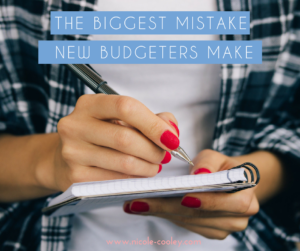The Biggest Mistake New Budgeters Make
 You’re all pumped; You are going to do this for REAL this time. You are going to conquer the budget game!
You’re all pumped; You are going to do this for REAL this time. You are going to conquer the budget game!
So you diligently set up a monthly budget that you vow to stick to…
but pretty soon you realize it isn’t working.
You start busting through certain budget categories early in the month and realize certain categories are missing altogether. You’re frustrated! How do other people get this right?
This is the point where most people give up. They don’t realize they missed a critical step.
In fact, to do this budgeting thing right, your first month of budgeting shouldn’t look much like budgeting at all…
because there won’t be a ‘real’ budget.
Before you can create a budget that will work, you have to take the time to gather some data and understand what your budget numbers should be.
If you guess, or start with target numbers of what you WISH your budget numbers could be it won’t work. You can’t start a budget based on guesses and wishes!
Instead, for a full month, you need to track your spending data to see what a normal month is for you in all your main categories. How much do you normally spend on groceries? Clothes? Bills? It is vital to understand the baseline of what you are starting with before you try to cut back or hold yourself under a certain threshold.
This is super important because your brain WILL trick you into thinking your spending is different than it really is. We like to round down, write stuff off as a one time expense or not look at the impact of how stuff adds up throughout the month.
I always have my clients do a ‘guess’ budget that first month they work with me. One of my favorite things to do as a coach is watch the numbers roll in and see where they thought the dollars would flow versus where they actually do.
The numbers are the facts. And you need some facts to build a sustainable budget.
So if you are just getting started with budgeting follow these four simple steps to get started:
1) Build a ‘guess’ budget.
You aren’t holding yourself to these numbers, you are simply guessing at how much you spend in each category in a given month. The point is to capture what you THINK is happening.
2) Track your numbers for one month in your plan, without any major spending adjustments.
Track all your expenses just like you would if you had a ‘real’ budget. Remember, the goal is to see what your ‘normal’ is.
3) Analyze your numbers to discover where you would like to make changes.
When you have a month of data you will identify budget numbers that feel good and don’t need to be adjusted, and you will see some numbers that feel to high and you want to work on.
4) Now you can start to adjust your budget to a level that works, but is also realistic.
If you can create an action plan to cut back that focuses on a few specific categories, you will find it easier to hit your goals.
Remember, most people slowly improve over time. The first version of your budget should never be your last. It should be updated and adjusted every month to account for your progress and goals.
Trust me when I say that taking a month to gather data is key! And it won’t delay any progress you are trying to make in your finances. Just starting to think about tracking and starting to look at the numbers will make you start to think twice before you swipe that card.
Take the time to lay a strong foundation for how you build your budget. Then you will have a budget that is sustainable… and works.
